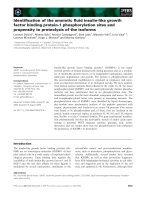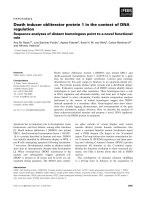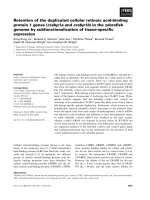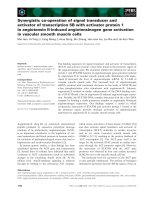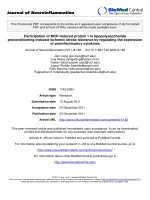Proline rich acidic protein 1 in life and death 4
Bạn đang xem bản rút gọn của tài liệu. Xem và tải ngay bản đầy đủ của tài liệu tại đây (2.01 MB, 39 trang )
99
induction of PRAP1 mRNA expression by serum deprivation and ethanol. The
common mechanism of action underlying the agents that induced PRAP1 mRNA
expression was DNA damage. We investigated whether PRAP1 is a genotoxic
responsive gene by using gamma irradiation, a well-characterized model to study
DNA-damage. Using real-time quantitative RT-PCR, we showed that PRAP1
mRNA transcript levels were induced by gamma irradiation in a time-dependent
manner (Figure 3.31-B). The expression of PRAP1 mRNA was induced by four-
fold at four hours after exposure to gamma irradiation. The response to DNA-
damage peaked at six-fold, six hours after gamma irradiation. These results
indicated that PRAP1 mRNA levels are regulated by DNA damage.
3.5.2 Transcriptional regulation of PRAP1 by genotoxic agents
To further study the regulation of PRAP1 by the various stressors, we
selected 5-FU and CPT for our downstream studies as they induced the highest
levels of PRAP1 mRNA and are used in the treatment of colorectal cancer. Firstly,
we investigated whether the regulation of PRAP1 occurs at the transcriptional
level. To achieve that, we first characterized the PRAP1 promoter in HCT 116 by
using various PRAP1 promoter constructs as described previously under section
3.2.2.1. The majority of the promoter constructs showed an average promoter
activity of 30-fold over baseline levels (without promoter) (Figure 3.32). The
longest PRAP1 promoter construct was 3900bp long and demonstrated the highest
promoter activity (50-fold). In HCT 116 cells, the core promoter was also
identified to be within 203 base pairs upstream of PRAP1 transcription start site
(Figure 3.33), similar to our previous observation in another cell line, L8 (Figure
3.20).
100
Figure 3.31 PRAP1 is induced by genotoxic stressors
A: Representative RT-PCR gel picture showing the expression of prap1 and
gapdh in HCT 116 cells after treatment with the indicated stressors (5-FU (25
µM), camptothecin (20 nM), etoposide (20 µM), serum free medium or 5%
ethanol for 48 hours; hydrogen peroxide (100 µM) for 1 hour and recovered for 4
hours; and UV (20J)).
B: Representative graph showing fold induction of prap1 expression in HCT 116
cells after treatment with gamma-irradiation and recovered at 4, 6 and 24 hours.
Real-time RT-PCR was performed and relative expression of prap1 was
normalized against gapdh and calculated as fold induction. Column, mean of
duplicates; Bar, SEM.
101
Figure 3.32 Luciferase assay to identify the regions required for the prap1
gene promoter activity in HCT 116 cells
Left panel: Illustration representing various portions of the prap1 5’ flanking
region of the prap1 gene subcloned upstream of the firefly luciferase gene (pGL3-
Basic). The number in the box indicates the size of each prap1 fragment with
respect to the transcription start site (+1).
Right panel: Representative figure showing the fold induction of prap1 promoter
activity of each fragment in HCT 116. For each transfection, the firefly luciferase
activity was normalized with the Renilla reniformis luciferase activity by the
cotransfected pRL-TK. The relative activity of each construct is expressed as a
ratio to the activity of the pGL-Basic. Bar, mean of three replicates. Bar, SE.
Figure 3.33 Identification of core promoter of prap1 gene
Left panel: Illustration showing the deletion construct pGL (-461/-203) generated
by deleting the 203 base pairs upstream of the transcription start site from the
pGL(-461/0) construct.
Right panel: Representative figure showing the fold induction of prap1 promoter
activity of each construct in HCT 116. The promoter activity was measured as
described in Figure 3.32. Column, mean of three replicates; Bar, SE.
102
To study the transcriptional regulation of PRAP1 by genotoxic agents, the
longest promoter construct, pGL(-3900/0) and the core promoter construct, pGL(-
203/0) of PRAP1 were used. There was a two-fold increase in the core promoter
activity after exposure to either 5-FU or CPT, as compared to the untreated control
(Figure 3.34). This demonstrated that induction of PRAP1 was regulated at the
transcriptional level. However, this two-fold increase in the transcriptional activity
does not seem to fully account for the marked induction of PRAP1 mRNA by the
genotoxic agents as shown in Figure 3.35, suggesting the possible involvement of
other transcriptional regulatory mechanisms such as cis- or trans-regulatory
elements and/or stability of mRNA.
3.5.3 Regulation of PRAP1 protein by genotoxic agents
In order to study the intracellular level of PRAP1, which is a highly
secreted protein (Zhang, Wong et al. 2003), we used Brefeldin A (BFA), a lactone
antibiotic that inhibits the protein transport from the endoplasmic reticulum (ER)
to the Golgi apparatus, to trap PRAP1 in the ER (Pelham 1991; Klausner,
Donaldson et al. 1992). After exposing HCT 116 cells to 5-FU and CPT for 48
hours, PRAP1 was trapped in the ER with BFA for 6 hours before harvesting. As
shown in Figure 3.36, PRAP1 protein was highly induced by both 5-FU and CPT
at various dosages which corresponded to the increase observed at the mRNA
level. 5-FU induced a higher level of PRAP1 protein expression as compared to
that of the CPT at all doses. The induction of PRAP1 by CPT was dose-dependent
whereas the induction of PRAP1 by 5-FU was saturated at the lowest dosage used.
Our results indicated genotoxic stress can induce the expression of PRAP1 at both
mRNA and protein levels.
103
Figure 3.34 Induction of prap1 promoter activity by 5-FU and CPT
The longest promoter construct (pGL-3900) and core promoter construct (pGL-
203) were cotransfected with pRL-TK into HCT 116 cells for 24 hours. 5-
fluorouracil, 25µM of 5-FU (A) and 20nM of camptothecin, CPT (B) was added
to the cells for another 24 hours. The firefly luciferase activity was normalized
with the Renilla reniformis luciferase activity. Promoter activity of each construct
was expressed as fold induction relative to that of the pGL3-Basic. Column, mean
of three replicates; Bar, SE.
104
Figure 3.35 Induction of PRAP1 by 5-FU and CPT at mRNA level
Representative RT-PCR gel picture showing the mRNA expression of prap1 and
gapdh in the cells from Figure 3.34.
Figure 3.36 PRAP1 was induced at protein level by 5-FU and CPT
Representative western blot of PRAP1 and GAPDH in HCT116 cells after
treatment with the indicated doses of either 5-fluorouracil (5-FU) or camptothecin,
(CPT) or untreated (control) for 48 hours. Brefeldin A was added to trap the
PRAP1 protein in endoplasmic reticulum for 6 hours before harvesting.
Cytoplasmic protein (100 µg) was subjected to western blot analysis with a
specific anti-PRAP1 antibody. The membrane was reprobed with anti-GAPDH
antibody to confirm equal loading.
105
3.5.4 Dose- and time-dependent regulation of PRAP1
To study the dose and time response of PRAP1 mRNA level by 5-FU and
CPT, HCT 116 cells were treated with different doses of 5-FU (2.5 and 25 µM)
and CPT (20 and 250nM) for 3 days. Cells were harvested for RT-PCR and
western blot analysis at 24, 48 and 72 hours. The expression of PRAP1 mRNA
was induced as early as 24 hours and sustained at 72 hours when treated with both
low and high doses of 5-FU (Figure 3.37). In the presence of low dose of CPT,
PRAP1 mRNA was induced at 24 hours and peaked at 48 hours, whereas with
high dose of CPT, the expression of PRAP1 mRNA peaked at 24 hours.
The time-course regulation of PRAP1 expression at protein level was
studied over 72 hours using high doses of 5-FU or CPT. The induction of PRAP1
protein by 5-FU occurred as early as 24 hours and peaked at 48 hours (Figure
3.38), whereas the induction of PRAP1 by CPT peaked at 24 hours. This
temporal regulation of PRAP1 by genotoxic stress suggests that it has a specific
temporal function in the cellular response to genotoxic stress.
3.6 Wild-type-p53-dependent induction of PRAP1
3.6.1 Genotoxic agents failed to induce PRAP1 in p53-/- cells
As p53 plays an important role in the response to DNA damage (Sionov
and Haupt 1999), we investigated whether p53 is a regulator of PRAP1 expression
upon exposure to DNA damage agents. We used two cell lines derived from the
parental HCT 116 cells, one with p53 knockout (p53-/-) and one with p21
knockout (p21-/-). PRAP1 mRNA was induced in both HCT 116 wild-type and
p21-/- cell lines, but not in p53-/-
106
Figure 3.37 Early upregulation of PRAP1 in a dose- and time-dependent
manner
Representative RT-PCR gel picture of prap1 and gapdh in HCT 116 cells after
treatment with 5-FU and CPT at the indicated doses for 24, 48 and 72 hours.
Figure 3.38 Early upregulation of PRAP1 protein by 5-FU and CPT
Representative western blot of PRAP1 and GAPDH in HCT116 cells after
treatment with 5-FU (25µM) and CPT (20nM) for 24, 48 and 72 hours. Brefeldin
A was added to trap the PRAP1 protein in endoplasmic reticulum for 6 hours
before each harvesting. Cytoplasmic protein (100 µg) was subjected to
immunoblot analysis with a specific anti-PRAP1 antibody. The membrane was
reprobed with anti-GAPDH antibody to confirm equal loading.
107
cells at both low and high doses of 5-FU and CPT (Figure 3.39). These results
suggested that induction of PRAP1 by DNA damaging agents was dependent on
p53.
3.6.2 Restoration of PRAP1 induction by reintroduction of wild-type p53 in
p53-/- cells
To confirm that the induction of PRAP1 was dependent on p53, we
reintroduced the wild type p53, pCMV-p53 (WT) or the DNA-binding deficient
mutant p53, pCMV-p53mt153 (Mut) into p53-/- cells. Our results showed that, the
PRAP1 mRNA was detectable in WT-transfected p53-/- cells, but not in Mut or
empty vector-transfected p53-/- cells, suggesting that PRAP1 may be a direct
target gene of p53. In the presence of 5-FU or CPT, the expression of PRAP1
mRNA was further induced in the WT-transfected p53-/- cells, but not in the Mut
or vector-transfected cells (Figure 3.40). This indicated that the induction of
PRAP1 requires the expression of wild-type p53. While p53 is best characterized
as a transcription factor, the data presented here does not distinguish between the
following two possible roles of p53 in the induction of PRAP1 expression
following exposure to DNA damaging agents. Firstly, PRAP1 may be a direct or
indirect transcriptional target of p53. Secondly, p53 which is a DNA binding
protein, may displace an unknown repressor from the PRAP1 promoter.
3.6.3 Genotoxic agents failed to induce PRAP1 in Hep 3B and HT 29 cells
To further validate that wild-type p53 is required for the induction of
PRAP1 expression by genotoxic agents, we used two cell lines with inherent p53
defects: HT 29, a cell line with transcriptional mutant p53 (HT 29) and Hep 3B, a
108
Figure 3.39 Induction of prap1 by 5-FU and CPT is dependent on p53
Representative RT-PCR gel picture of prap1 and gapdh in HCT116 cells and its
two derivatives, p53-/- and p21-/- after treatment with the indicated doses of 5-FU
and CPT for 24 hours.
Figure 3.40 Reintroduction of wild-type p53 rescues the induction of prap1 by
5-FU and CPT in p53-/- cells
Representative RT-PCR gel picture of prap1 and gapdh in p53-/- cells after
transfection with either empty vector control (V) or wild-type p53 (WT) or mutant
p53 (Mut), followed by treatment with either 5-FU (25µM) or CPT (20nM) for 24
hours.
109
cell line with p53 deficiency. Consistent with our observation, both 5-FU and CPT
failed to induce PRAP1 mRNA expression in HT 29 and Hep 3B cells as
compared to their respective p53 wild-type cell lines, HCT 116 and Hep G2
(Figure 3.41). These results support the conclusion that the induction of PRAP1
by DNA damage agents is dependent on wild-type p53.
3.7 PRAP1 is a novel p53-responsive gene
3.7.1 Identification of p53-response elements in PRAP1 gene
Following confirmation that induction of PRAP1 is dependent on wild-
type p53, we investigated whether p53 was able to regulate PRAP1 directly at the
transcriptional level. Using an algorithm designed to search for potential p53
binding sites (Hoh, Jin et al. 2002), we identified two potential p53-responsive
elements within intron 1 of PRAP1. The sequences of these two p53 responsive
elements in PRAP1 matched the consensus p53 binding site used by the algorithm
by 84% and 70% (Table 3.11). In comparison, the known p53-response element in
p21 promoter showed a match of 90%. The positions of the two p53-responsive
elements (+1316 and +1460) in PRAP1 are illustrated in Figure 3.42.
In order to determine whether the two identified p53-response elements in
PRAP1 (PRAP1-p53BS) are functional, we amplified the intronic fragment from
positions +1197 to +1534 which contains both p53-response elements of PRAP1.
This fragment was cloned into a pGL3-promoter luciferase reporter vector
upstream of a minimal SV-40 promoter as illustrated in Figure 3.43. The
constructed plasmid (pGL3-PRAP) was checked by restriction enzyme digestion
(insert size, 337bp; Figure 3.44) and verified by sequencing.
110
Figure 3.41 Hep 3B and HT 29 cells failed to induce prap1 gene expression
Representative RT-PCR gel picture of prap1 and gapdh in HCT 116 (p53 WT)
versus HT 29 (p53 mutant) and Hep G2 (p53 WT) versus Hep 3B (p53 deficient)
cells after treatment with 5-FU (25µM) and CPT (20nM) for 48 hours.
111
Figure 3.42 Schematic diagram of PRAP1 gene
Two p53 binding sites were identified in intron 1 of PRAP1. Their distribution
and position was showed in the diagram with transcription start site of PRAP1
gene denoted as +1.
Table 3.11 Sequences of the two p53 binding sites located in PRAP1 gene
The consensus sequence of p53 was showed in the second row of the table. The
p53 binding site located in p21 was included as positive control for comparison.
Row three and four indicate the sequences of p53 binding site in PRAP1 gene as
predicted by the algorithm.
112
Figure 3.43 Schematic diagram of p53 binding site of PRAP1 gene construct
The two p53 response elements (blue) within the first intron 1 of PRAP1 gene
were cloned into the luciferase reporter plasmid (pGL3-Promoter) before the SV
40 promoter as showed in the diagram.
Figure 3.44 Verification of the p53 binding sites constructed plasmid
Representative DNA agarose gel picture of the amplified insert in the constructed
plasmid (PRAP1) and the empty plasmid (Vector). A size difference of about
300bp was observed that indicated the presence of p53 binding sites.
113
3.7.2 p53-response elements in PRAP1 gene are responsive to wild-type p53
To examine the responsiveness of these two potential p53-response
elements in intron 1 of PRAP1, the pGL3-PRAP construct was transiently
cotransfected with empty pCMV (Vector), pCMV-p53 (p53 WT) or pCMV-
p53mt153 (p53 Mut) into p53-/- cells. In this study, the p53-response element in
p21 (pGL3-p21) was used as a positive control for comparison. The empty pGL3-
Promoter vector was used as negative control. We found that transfection of p53
WT, but not Vector or p53 Mut, increased the SV-40 promoter activities by about
three-fold in cells transfected with pGL3-PRAP (Figure 3.45). The extent of the
enhanced SV-40 promoter activity by the two p53-response elements in PRAP1
gene was comparable to that of the p21. These results demonstrated that the p53-
response elements in PRAP1 were functionally as effective as that in p21 in
mediating p53-induced gene transcriptional activation.
3.8 PRAP1 modulates cell fate after genotoxic stress
3.8.1 Repression of PRAP1 induction by siRNAs
After p53 activation upon DNA damage, mammalian cells either execute
cell cycle arrest, senescence or apoptosis. To investigate the biological functions
of p53 mediated PRAP1 induction, we determined the effects of PRAP1 inhibition
by siRNA on p53-induced cellular response such as apoptosis. To achieve this, we
used two custom-made synthetic siRNAs that target PRAP1 (PRAP1 siRNA1 and
PRAP1 siRNA2). These sequences are verified to be PRAP1-specific using
BLAST from NCBI Web Page. To account for the non-specific effect of siRNA,
we generated two corresponding control siRNAs by mutating 4 bases of PRAP1
siRNA1 and 2 (control siRNA1 and control
114
Figure 3.45 Predicted p53 binding elements of PRAP1 response to wild-type
p53
Representative figure showing the fold induction of SV40 promoter activity of
pGL3-P (basic vector), pGL3-PRAP and pGL3-p21 cotransfected with pcDNA
vector, pcDNA-p53 and pcDNA-p53Mut in p53-/- cells for 48 hours. For each
transfection, the firefly luciferase activity was normalized with the Renilla
reniformis luciferase activity by the cotransfected pRL-TK. The relative activity
of each construct is expressed as a ratio to the activity of the pGL3-P. pGL3-P,
Basic luciferase promoter; pGL3-PRAP, Basic luciferase promoter plasmid
constructed with the two p53 binding elements of PRAP1 gene; pGL3-p21, Basic
luciferase promoter plasmid constructed with the p53 binding elements of p21
gene (serving as a positive control for comparison); Vector: pcDNA vector; p53
WT: pcDNA with wild type p53 construct; p53 Mut: pcDNA with mutant p53.
115
siRNA2). These sequence-specific control siRNAs do not target any mammalian
genes or PRAP1 gene.
HCT 116 cells were plated for 24 hours and cells were transfected with
PRAP1 siRNAs or control siRNAs. 48 hours after siRNA transfection, these cells
were treated with 5-FU for another 24 hours prior to harvesting for mRNA and
protein analysis. The PRAP1 induced by 5-FU was effectively repressed by
PRAP1 siRNAs at both mRNA (Figure 3.46) and protein level (Figure 3.47) as
compared to their respective control siRNAs. PRAP1 siRNA1 has a greater
silencing effect than that of PRAP1 siRNA2. The sequence-specific control
siRNAs did not target the PRAP1 gene. These results indicated that we have
generated an effective and specific siRNA system to repress e 5-FU induced
PRAP1 expression.
3.8.2 Effect of PRAP1 knockdown on colony formation
The effect of PRAP1 repression on the efficacy of 5-FU in inhibiting the
establishment and growth of colonies in HCT 116 cells was studied over a period
of 7 days. Our results showed that PRAP1 knockdown cells exhibited a significant
reduction in their size and the number of colonies formed as compared to their
respective control siRNAs (Figure 3.48). There was about 50% reduction in the
number of colonies formed in cells with PRAP1 knockdown treated with 3 µM 5-
FU as compared to that of control siRNAs. At a higher dose of 5-FU (6 µM), the
number of colonies was reduced by 80% (Figure 3.49). These results indicated
that the inhibition of the induced PRAP1 expression by 5-FU enhanced the anti-
tumor effect of 5-FU, suggesting that expression of PRAP1 is able to modulate the
response of cells to the cytotoxicity of genotoxic agents.
116
Figure 3.46 Suppression of PRAP1 induction by 5-FU at mRNA level
Representative RT-PCR agarose gel picture of prap1 and gapdh in HCT 116 after
transfection with PRAP1 specific siRNA (PRAP1 siRNA1 and 2) or PRAP1
siRNA specific control siRNA (control siRNA1 and 2) for 48 hours, and followed
by the addition of 5-FU for another 24 hours.
Figure 3.47 Suppression of PRAP1 induction by 5-FU at protein level
Representative western blot of PRAP1 and GAPDH in HCT 116 after transfection
with PRAP1 specific siRNA (PRAP1 siRNA1 and 2) or PRAP1 siRNA specific
control siRNA (control siRNA1 and 2) for 48 hours, and followed by the addition
of 5-FU for another 24 hours. Brefeldin A was added 6 hours before harvesting to
prevent PRAP1 from being secreted by trapping it in endoplasmic reticulum. A
total of 100μg of cytoplasmic protein was loaded for the analysis.
117
Figure 3.48 Repression of PRAP1 expression reduces colony numbers
Representative result of colony formation assay performed on HCT116 cells. The
cells were transfected with either control siRNAs or PRAP1 siRNAs. After 48
hours, cells were treated with 5-FU for 24 hours. Cells were then replated and
maintained for 7 days in culture for colony formation. Colonies were stained with
crystal violet for visualization. Representative images were taken.
Figure 3.49 Summary of the number of colonies formed
Total number of colonies for each assay were counted using ImageJ. A statistical
analysis of the colony formation assay was performed. Column, mean of 3
replicates; Bars, SEM. * p<0.05.
118
3.8.3 Effect of PRAP1 knockdown on sub-G1
To further validate the cell death effect of PRAP1 inhibition, we used flow
cytometry to look at the population of cells in the sub-G1 phase of cell cycle as a
measure of apoptosis. PRAP1 knockdown cells treated with 5-FU for 24 hours
were harvested and stained with propidium iodide. DNA content was analyzed
with flow cytometry. Consistent with our previous observation (section 3.8.2), a
significant increase in cell death was measured. There was a 2-fold increase in the
sub-G1 population in cells with inhibition of PRAP1 expression as compared to
that of the control siRNAs (Figure 3.50). These data supported the conclusion that
repression of PRAP1 induction leads to an enhancement of the cytotoxic effect of
genotoxic chemotherapeutic agents.
3.8.4 Effect of PRAP1 knockdown on DNA damage
To investigate the nature of this enhanced cell death effect, we examined
the extent of DNA damage using comet assay and micronuclei assay. In comet
assay, a comet tail that is proportional to the amount of DNA damage was
measured as tail movement. PRAP1 knockdown enhanced the DNA damage
induced by 5-FU by 2.5 fold (Figure 3.51). Furthermore, the micronuclei assay, a
reliable indicator of chromosomal damage and genomic instability, showed a
marked increase in micronucleus frequency in cells with PRAP1 knockdown
(4.3% vs 0.74%, Figure 3.52). Together, these results demonstrated that the
repression of PRAP1 induction resulted in an increase in the DNA damage effect
of these genotoxic agents.
119
Figure 3.50 Repression of PRAP1 expression enhances the cell death induced by 5-FU
Representative figure showing the percentage of sub-G1 (dying cells) population of HCT116 cells after transfection with either control siRNA or
PRAP1 siRNAs for 48 hours, and followed by the addition of 5-FU for 24 hours. Both floating and adherent cells were harvested and subjected
to DNA content analysis by flow cytometry. Column, mean of 3 replicates; Bars, SEM. *p<0.05.
120
0
1
2
3
4
5
6
Control siRNA1 PRAP1 siRNA1
Tail Movement
Figure 3.51 Repression of PRAP1 expression enhances 5-FU induced DNA
damage measured by comet assay
Representative figure showing the tail movement of damaged DNA in HCT 116
after transfection with control siRNA1 and PRAP1 siRNA1 for 48 hours, and
followed by the addition of 5-FU for 24 hours. Cells were harvested and subjected
to comet assay. The DNA damage distribution was measured as tail moment
(product of tail length and fraction of DNA). The tail movement was captured and
analyzed using the Metasystems (Altussheim, Germany) software “Comet imager
version 1.2”. One hundred random chosen comets were analyzed per sample.
Columns, mean of 100 cells scored; Bars, SEM.
0
1
2
3
4
5
Control siRNA1 PRAP1 siRNA1
MN frequency (%)
Figure 3.52 Repression of PRAP1 expression enhances 5-FU induced DNA
damage as measured by micronuclei assay
Representative figure showing the frequency of micronuclei in HCT 116 cells.
The cells were treated as described in Figure 3.51 and subjected to micronuclei
assay analysis. One thousand mono-nucleated cells were scored under microscope
for each sample. DNA damage was expressed as the percentage of cells with
micronuclei.
121
3.9 PRAP1 and cell cycle checkpoints
3.9.1 Enhanced cell death is accompanied by abrogation of S-phase arrest
As shown previously in Figure 3.52, there was little antitumor activity
when cells were treated with 5-FU within the therapeutic range (1 to 10μM). In
addition, cells with PRAP1 knockdown showed a very distinct morphology
compared to that of the control siRNA after 5-FU treatment (Figure 3.53). Control
cells treated with 5-FU appeared to be bigger in size and rounder as compared to
the untreated cells, which may indicate that cells are undergoing cell division.
However, cells treated with PRAP1 siRNA exhibited a more elongated
morphology and a smaller cell size as compared to that of the control siRNA
treated cells. We investigated whether repression of PRAP1 would interfere with
cell cycle profile. To achieve that, we used flow cytometry to analyze the different
cell cycle phase of the cells. Our result showed that treatment of cells with 5-FU
transfected with control siRNA or untransfected primarily resulted in cell cycle
arrest at S-phase (indicated by the box) with minimal cell death (Figure 3.54). In
contrast, cells treated with PRAP1 siRNA1 or siRNA2 exhibited a marked
decrease of cells in S-phase with a significant increase in cell death. Together,
these results suggested that PRAP1 may play a role in the S-phase arrest induced
by 5-FU.
3.9.2 Effect of PRAP1 knockdown on cyclins and CDKs
Mammalian cell cycle is controlled by a family of protein complexes. The
main cell cycle protein complexes involved in G1/S-phase are cyclin D/CDK4 and
cyclin E/CDK 2 complexes. Both mock transfection and control siRNA showed
122
Figure 3.53 Repression of PRAP1 expression results in morphological
changes
Representative phase-contrast images showing the morphology of HCT116 cells
after transfection with control siRNA or PRAP1 siRNA for 48 hours, and
followed by addition of 5-FU for 24 hours (320X Magnification).
123
Figure 3.54 Repression of PRAP1 expression abrogates the S-phase arrest induced by 5-FU
Representative histograms showing the cell cycle distribution of HCT116 cells after transfection with control siRNA or PRAP1 siRNA 1 and 2
for 48 hours, and followed by the addition of 5-FU for 24 hours. Total cells were harvested and stained with propidium iodide for DNA content
analysis by flow cytometry. Box indicates population of cells at S-phase.
